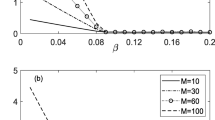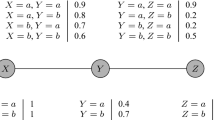Abstract
This paper proposes and characterizes a sequential decision aggregation system consisting of agents performing binary sequential hypothesis testing and a fusion center which collects the individual decisions and reaches the global decision according to some threshold rule. Individual decision makers’ behaviors in the system are influenced by other decision makers, through a model for social pressure; our notion of social pressure is proportional to the ratio of individual decision makers who have already made the decisions. For our proposed model, we obtain the following results: First, we derive a recursive expression for the probabilities of making the correct and wrong global decisions as a function of time, system size, and the global decision threshold. The expression is based on the individual decision makers’ decision probabilities and does not rely on the specific individual decision-making policy. Second, we discuss two specific threshold rules: the fastest rule and the majority rule. By means of a mean-field analysis, we relate the asymptotic performance of the fusion center, as the system size tends to infinity, to the individual decision makers’ decision probability sequence. In addition to theoretical analysis, simulation work is conducted to discuss the speed/accuracy tradeoffs for different threshold rules.






Similar content being viewed by others
References
Wald A (1945) Sequential tests of statistical hypotheses. Ann Math Stat 16(2):117–186
Shiryaev AN (1961) On optimum methods in quickest detection problems. Theory Probab Appl 8(1):22–46
Woudenberg F (1991) An evaluation of Delphi. Technol Forecast Soc Change 40(2):131–150
Tsitsiklis JN (1993) Decentralized detection. Adv Stat Signal Process 2:297–344
Irving WW, Tsitsiklis JN (1994) Some properties of optimal thresholds in decentralized detection. IEEE Trans Autom Control 39(4):835–838
Veeravalli VV, Başar T, Poor HV (1994) Decentralized sequential detection with sensors performing sequential tests. Math Control Signals Syst 7(4):292–305
Varshney PK (1997) Distributed detection and data fusion. Springer, New York
Veeravalli VV (2001) Decentralized quickest change detection. IEEE Trans Inf Theory 47(4):1657–1665
Goldenberg J, Libai B, Muller E (2001) Talk of the network: a complex systems look at the underlying process of word-of-mouth. Mark Lett 12:211–223
Chamberland JF, Veeravalli VV (2003) Decentralized detection in sensor networks. IEEE Trans Signal Process 51:407–416
Gale D, Kariv S (2003) Bayesian learning in social networks. Games Econ Behav 45(2):329–346
Kerr NL (2004) Group performance and decision making. Ann Rev Psychol 55:623–655
Gardner M, Steinberg L (2005) Peer influence on risk taking, risk preference, and risky decision making in adolescence and adulthood: an experimental study. Dev Psychol 41(4):625–635
Bharathi S, Kempe D, Salek M (2007) Competitive influence maximization in social networks. Internet Netw Econ 4858:306–311
Carnes T, Nagarajan C, Wild SM, van Zuylen A (2007) Maximizing influence in a competitive social network: a follower’s perspective. In: International conference on electronic commerce. Minneapolis, USA, pp 351–360
Le Boudec JY, McDonald D, Mundinger J (2007) A generic mean field convergence result for systems of interacting objects. In: International conference on quantitative evaluation of systems. Edinburgh, Scotland, pp 3–18
Epstein LG, Noor J, Sandroni A (2008) Non-bayesian updating: a theoretical framework. Theor Econ 3(2):193–229
Acemoglu D, Dahleh MA, Lobel I, Ozdaglar A (2011) Bayesian learning in social networks. Rev Econ Stud 78(4):1201–1236
Acemoglu D, Ozdaglar A (2011) Opinion dynamics and learning in social networks. Dyn Games Appl 1(1):3–49
Lorenz J, Rauhut H, Schweitzer F, Helbing D (2011) How social influence can undermine the wisdom of crowd effect. Proc Natl Acad Sci 108(22):9020–9025
Dandach SH, Carli R, Bullo F (2012) Accuracy and decision time for sequential decision aggregation. Proc IEEE 100(3):687–712
Kimura M, Moehlis J (2012) Group decision-making models for sequential tasks. SIAM Rev 54:121–138
Jadbabaie A, Molavia P, Sandroni A, Tahbaz-Salehi A (2012) Non-bayesian social learning. Games Econ Behav 76(1):210–225
Shirazipourazad S, Bogard B, Vachhani H, Sen A, Horn P (2012) Influence propagation in adversarial setting: how to defeat competition with least amount of investment. In: ACM international conference on information and knowledge management. Maui, USA, pp 585–594
Baddeley M, Parkinson S (2012) Group decision-making: an economic analysis of social influence and individual difference in experimental juries. J Soc Econ 41(5):558–573
Srivastava V, Leonard NE (2014) Collective decision-making in ideal networks: the speed-accuracy trade-off. IEEE Trans Control Netw Syst 1(1):121–132
Goyal S, Heidari H, Kerans M (2014) Competitive contagion in networks. Games Econ Behav (in press)
Tinson JS, Nuttall PJ (2014) Social collective decision making among adolescents: a review and a revamp. Psychol Mark 31(10):871–885
Kempe D, Kleinberg J, Tardos E (2015) Maximizing the spread of influence through a social network. Theory Comput 11(4):105–147
Poulakakis I, Young GF, Scardovi L, Leonard NE (2015) Information centrality and ordering of nodes for accuracy in noisy decision-making networks. IEEE Trans Autom Control 61(4):1040–1045
Author information
Authors and Affiliations
Corresponding author
Additional information
This work was supported by the Institute for Collaborative Biotechnologies through Grant W911NF-09-D-0001 from the U.S. Army Research Office and through Grant W911NF-15-1-0274 from the U.S. Army Research Office. The content of the information does not necessarily reflect the position or the policy of the Government, and no official endorsement should be inferred.
Rights and permissions
About this article
Cite this article
Mei, W., Bullo, F. Sequential decision aggregation with social pressure. Math. Control Signals Syst. 28, 23 (2016). https://doi.org/10.1007/s00498-016-0174-5
Received:
Accepted:
Published:
DOI: https://doi.org/10.1007/s00498-016-0174-5




